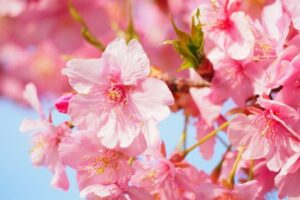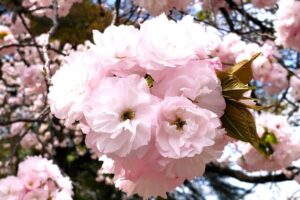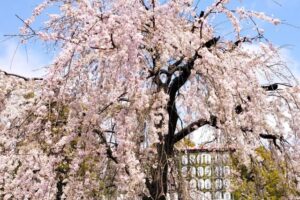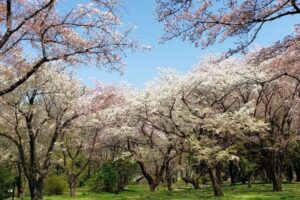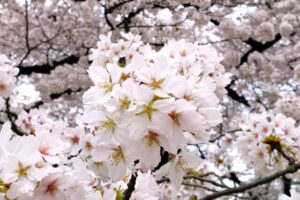七五三を英語で説明|由来や行事の内容を5つの例文で簡単に紹介
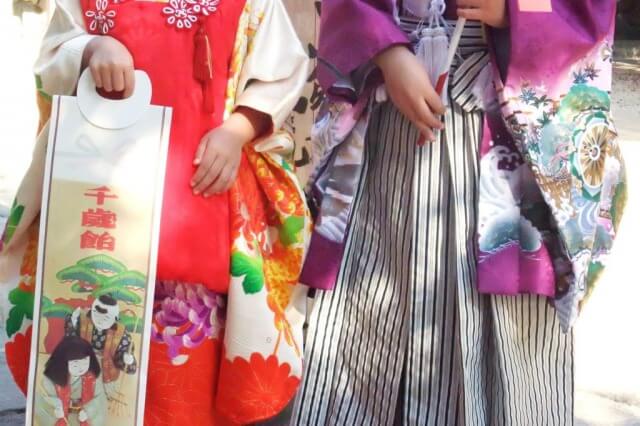
外国人から「七五三って何ですか?」と聞かれたら、英語で答えられますでしょうか?
 woman
woman(「七五三」って何ですか?)
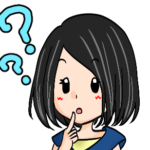


七五三って英語で何て説明すればいいのかしら?
外国人に七五三をどうやって説明すればいいのか?
そんな疑問にお答えします。
七五三は英語で「An event to celebrate the growth of children(こどもの成長を祝う行事)」です。



(七五三は3歳・5歳・7歳の子どもたちの成長を祝う行事で、11月15日に神社や寺院に参拝するのが習慣となっています。)
七五三について英語で説明する例文を一緒に見て行きましょう。
七五三を英語で説明
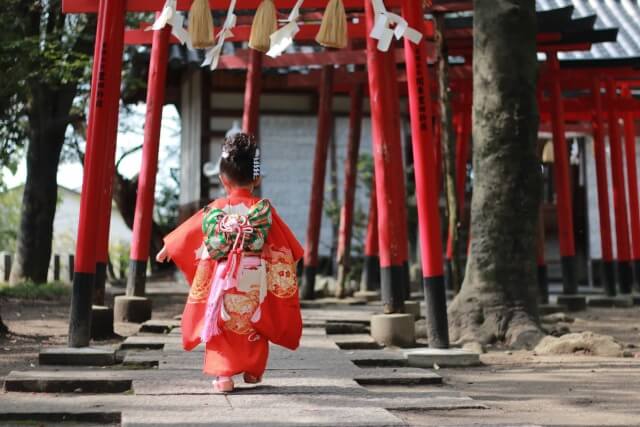

Shichigosan is an event to celebrate the growth of children and will be celebrated on November 15th.
七五三は、子どもたちの成長を祝う行事で、11月15日にお祝いをします。
- Shichigosan/七五三
- event/行事
- celebrate/祝う
- growth/成長
- children/子供たち
- November/11月
- 15th/15日
It is common for children to wear kimono and visit shrines or temples with their families.
子供たちは着物を着て、家族と一緒に神社かお寺を参拝するのが一般的です。
- common/一般的
- children/子供たち
- wear/着る
- kimono/着物
- visit/参拝する
- shrine/神社
- temple/寺院
- family/家族



(子供たちの成長をお祝いする日なのね。)
七五三の由来を英語で説明


The predominant theory is that Shichigosan started on December 24, 1681, praying for the health of Tokugawa Tokumatsu, the eldest son of Tsunayoshi Tokugawa, the fifth shogun of the Edo Shogunate.
七五三は、江戸幕府第五代将軍「徳川綱吉」の長男「徳川徳松」の健康を祈り、1681年12月24日に始まったという説が有力です。
- predominant/有力
- theory/説
- Shichigosan/七五三
- start/始まる
- December/12月
- pray/祈る
- health/健康
- Tokugawa Tokumatsu/徳川徳松
- eldest son/長男
- Tsunayoshi Tokugawa/徳川綱吉
- fifth/15代
- shogun/将軍
- Edo Shogunate/江戸幕府
Originally it was a custom in the Kanto region, but it gradually spread throughout the country.
もともと関東地方の風習でしたが、次第に全国に広まっていきました。
- originally/もともと
- custom/風習
- Kanto region/関東地方
- gradually/次第に
- spread/広まる
- throughout the country/全国に
In the old days when medical care was not as developed as it is today, infant mortality was so high that it was not natural to grow healthy until the age of seven.
現代のように医療が発達していなかった昔の時代には、幼児の死亡率は非常に高く、7歳まで健康に成長することは自然なことではありませんでした。
- old days/昔
- medical care/医療
- develop/発達する
- as/のように
- today/現代
- infant/幼児
- mortality/死亡率
- so/非常に
- high/高い
- natural/自然な
- grow/成長する
- healthy/健康に
- until/まで
- age/歳
- seven/7
From the ages of 3 to 7, it was thought that children were particularly vulnerable to illness as they grew up, so the ritual of praying for their growth, Shichigosan, began to take place.
3歳から7歳までは、子どもが成長するにつれて特に病気になりやすいと考えられたため、子どもの成長を祈る儀式である七五三が行われるようになりました。
- age/歳
- thought /think(考える)の過去形・過去分詞
- children/子供たち
- particularly/特に
- vulnerable to/受けやすい、に弱くて
- illness/病気
- as/につれて
- grew up/grow up(成長する)の過去形
- ritual/儀式
- pray/祈る
- growth/成長
- Shichigosan/七五三
- began/begin(始まる)の過去形
- take place/行う



(昔は子供たちの死亡率が高かったのね。)
七五三の行事の内容を英語で説明
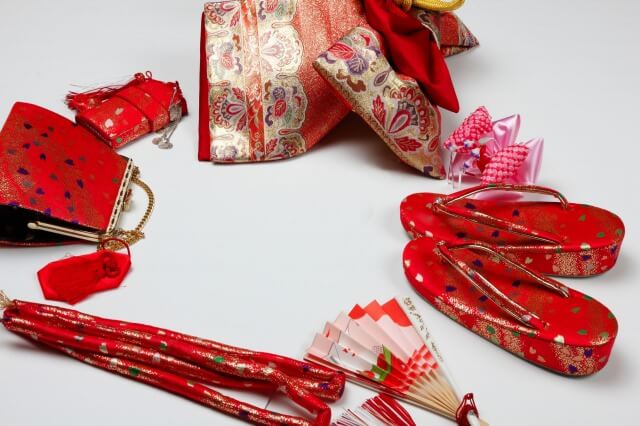

“Shichigosan” sounds like one event, but in reality it is a separate event for each age group.
「七五三」は1つの行事のように聞こえますが、実際には年齢ごとに別々の行事となっています。
- Shichigosan/七五三
- sound/聞こえる
- like/のように
- event/行事
- in reality/実際には
- separate/別々の
- each/それぞれの
- age/年齢
- group/集まり
3 years old: Kamioki
“Kamioki” is a ritual performed when children start to grow their hair.
At that time, babies had a habit of shaving, so from this day on, they were able to grow their hair.
3歳:髪置き(かみおき)
「髪置き」は子供が髪を伸ばし始める時に行われる儀式です。
当時、赤ちゃんは髪を剃る習慣があったので、この日から髪を伸ばすことができるようになりました。
- years old/歳
- Kamioki/髪置き(かみおき)
- ritual/儀式
- perform/行う
- children/子供たち
- start/始める
- grow/伸ばす
- hair/髪
- at that time/当時
- baby/赤ちゃん
- habit/習慣
- shaving/剃ること
- from this day on/この日から
- be able to/できる
5 years old: Hakamagi
“Hakamagi” is a ceremony in which boys begin to wear “Hakama” for the first time.
5歳:袴儀(はかまぎ)
「袴儀」は、男の子が初めて「袴」を身につけ始める儀式です。
7歳:帯解き(おびとき)
- years old/歳
- Hakamagi/袴儀(はかまぎ)
- ceremony/儀式
- boy/男の子
- begin/始める
- wear/着る
- Hakama/袴
- for the first time/初めて
7 years old: Obitoki
“Obitoki” is a ritual in which a girls stop wearing a kimono for children and begins to wear a “obi” that is the same width as an adult.
7歳:帯解き(おびとき)
「帯解き」は、女の子が子供用の着物を着るのをやめ、大人と同じ幅の「帯」を結び始める儀式です。
- years old/歳
- Obitoki帯解き(おびとき)
- ritual/儀式
- girl/女の子
- stop/やめる
- wear/着る
- kimono/着物
- children/子供たち
- begin/始める
- wear/着る
- obi/帯
- same/同じ
- width/幅
- as/のように
- adult/大人



(3歳、5歳、7歳で行う儀式をまとめて「七五三」と言うのね。)
七五三のお祝いの仕方を英語で説明


Depending on whether they are boys or girls, the age at which they celebrate Shichigosan is different.
男の子か女の子かで、七五三のお祝いをする年齢が異なります。
- depending on/によって
- whether/かどうか
- boy/男の子
- girl/女の子
- age/年齢
- celebrate/お祝いをする
- Shichigosan/七五三
- different/違う
At the age of three, both boys and girls celebrate the Shichigosan, but at the age of five only boys and at the age of seven only girls celebrate the Shichigosan.
3歳では男の子も女の子も七五三のお祝いをしますが、5歳は男の子だけ7歳は女の子だけが七五三のお祝いをします。
- at the age of/~歳のときに
- three/3
- both/両方
- boy/男の子
- girl/女の子
- celebrate/お祝いをする
- Shichigosan/七五三
- five/5
- only/だけ
- seven/7
Children wear kimonos and go to shrines or temples to pray.
子供たちは着物を着て神社か寺院にお参りに行き、祈祷をしてもらいます。
- children/子供たち
- wear/着る
- kimono/着物
- shrine/神社
- temple/寺院
- pray/お祈りをする
In addition, many people take a commemorative photo of Shichigosan at the photo studio.
また、写真館で七五三の記念写真を撮ってもらう人も多くいます。
- in addition/さらに
- many/たくさんの
- people/
- take a photo/写真を撮る
- commemorative/記念の
- Shichigosan/七五三
- photo studio/写真館



(子供たちは着物を着て神社か寺院にお参りにいくのね。)
七五三でもらう千歳飴を英語で説明
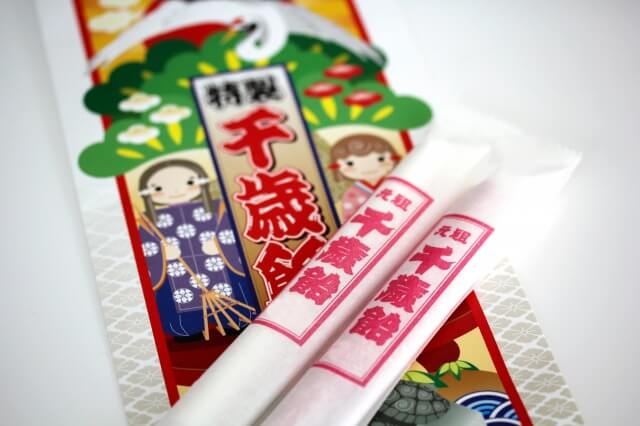

“Chitose candy” is a candy to eat at the celebration of Shichigosan.
「千歳飴」は、七五三のお祝いで食べる飴です。
- Chitose candy/千歳飴
- candy/飴
- eat/食べる
- celebration/お祝い
- Shichigosan/七五三
“Chitose” means “thousand years”, that is, “longevity”, and the candy has a long and thin shape.
「千歳」とは「千年」、つまり「長生き」という意味があり、飴は長細い形をしています
- Chitose/千歳
- mean/意味する
- thousand years/千年
- that is/すなわち
- longevity/長生き
- candy/飴
- long/長い
- thin/細い
- shape/形
The candy that has begun to harden after simmering sugar is stretched many times to form a layer.
砂糖を煮詰めた後に固まり始めた飴を、何度も引き延ばして層を作ります。
- candy/飴
- begun/
- harden/固まる
- after/後に
- simmer/煮詰める
- sugar/砂糖
- stretch/伸ばす
- many times/何度も
- form/つくる
- layer/層
As a result, innumerable fine air gaps are created in the transparent candy, creating a white color and a unique texture.
これにより、透明の飴の中に無数の空気の細かい隙間ができ、色が白く独特の食感が生まれます。
- as a result/その結果として
- innumerable/無数の
- fine/細かい
- air/空気
- gap/隙間
- create/作る
- transparent/透明の
- candy/飴
- white/白
- color/色
- unique/独特の
- texture/食感
“Chitose candy” is a red or white color that is said to be auspicious.
「千歳飴」は縁起が良いとされる紅か白の色となっています。
- Chitose candy/千歳飴
- red/赤
- white/白
- color/色
- it is said/と言われている
- auspicious/縁起が良い
“Chitose candy” is put in a bag with auspicious pictures such as crane turtle and pine, bamboo and plum .
「千歳飴」は鶴亀や松竹梅など、縁起の良い絵の描かれた袋に入れられています。
- Chitose candy/千歳飴
- put/入れる
- bag/袋
- auspicious/縁起の良い
- picture/絵
- such as/など
- crane/鶴
- turtle/亀
- pine/松
- bamboo/竹
- plum/梅
At a confectionery store that values tradition and style, the created “Chitose candy” is delivered to the shrine, and after performing a purification ceremony, it is displayed at the store.
伝統や格式を重んじる菓子屋では、作成した「千歳飴」を神社に納め、お祓いをしてもらってから店頭に並べます。
- confectionery/菓子
- store/店
- value/重んじる
- tradition/伝統
- style/格式
- create/作る
- Chitose candy/千歳飴
- deliver/運ぶ
- shrine/神社
- after/後
- perform/行う
- purification ceremony/お祓い
- display/陳列する



七五三を英語で説明|まとめ
いかがでしたでしょうか?
七五三には、年齢ごとに違う意味を持つ儀式があります。
7歳まで生きることが難しかった時代、七五三で子供の健やかな成長を祈る気持ちは、今よりもずっと強かったのではないかと想定されます。
医療の発達した現代に生まれたことに感謝しつつ、子供の成長を祈りたいですね。









